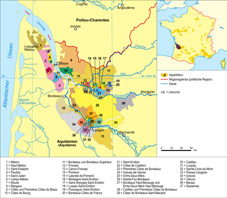
Ice-Breaker
Monday March 31, 2008
Arcachon Convention Centre
Salle des Ambassadeurs
19h00
Welcome Ceremony
Wednesday April 2, 2008
Hôtel de Ville de Bordeaux (Bordeaux Town Hall)
Place Pey Berland
33000 Bordeaux
Meeting point for JSC participants: 17h45 Arcachon Convention Center
Bus departure: 17h50
20h30: The Welcome Ceremony will be followed by a guided tour of Bordeaux by bus
Excursion
Saturday April 5, 2008 - full day (please fill in the registration form). Transfer to Bordeaux by bus on Saturday morning around 8am. (more information will be given during the JSC meeting)
Private cruise from Bordeaux to Blaye on a barge boat.
Meeting point for JSC participants: 8h15am Arcachon Convention Center
Bus Departure: 8h30am
Boat Departure: 9.45am
The cruise is organised by the association OCEAN
The cruise will start around 9.45am. The return to Bordeaux is scheduled around 6.30pm. We recommend you to stay overnight in Bordeaux and get your train or plane on Sunday morning, or to have a train or a plane late in the evening on Saturday from Bordeaux. If you plan to stay overnight in Bordeaux, take your suitcases with you for the excursion, they will be taken on board.
While sailing on the "Royal" from Bordeaux to Blaye, you will get some information about:
-
the story of the Garonne river
- the Gironde Estuary and the Amazone River. A presentation will be given by G. Abril (CNRS, EPOC) |
 |
| Before stopping for lunch in Blaye, you will enjoy on board a wine tasting of Côte de Blaye, Côte de Bourg and Medoc. |
Lunch: in Blaye in a restaurant (more information to come)
Visit of the Citadel of Blaye
On your way back to Bordeaux, you will enjoy the scenery of the costs, of the Estuary Islands, etc. |
 |
Top
Gironde Estuary
| Just after Bordeaux, the Garonne river meets the Dordogne river. The two rivers become the Gironde estuary which after approximately 60 miles joins the Atlantic Ocean. |
 |
| The estuary opens on the Atlantic Ocean where the entrance is marked by the historic lighthouse of Cordouan. The Garonne River extends 360 miles and is formed to the Northeast in the Central Mountains of France. The Dordogne is nearly as long as the Garonne. It runs east and then south all the way to the Pyrenees Mountains that divide France and Spain. |
|
|
Top
Blaye
Blaye is located on the right bank of the Gironde estuary (which is some 3 km wide at this point), 60 km north of Bordeaux.
The town has a citadel built by Vauban on a rock beside the river, and embracing in its enceinte ruins of an old Gothic château. The latter contains the tomb of Charibert II, king of Aquitaine, and son of Clotaire II. Blaye is also defended by the Fort Paté on an island in the river and the Fort Médoc on its left bank, both of the 17th century.
Blaye has a small river-port, and carries on trade in wine, brandy, grain, fruit and timber. The industries include the building of small vessels, distilling, flour-milling, and the manufacture of oil and candles. Fine red wine is produced in the district.
Top
Wine Regions of Bordeaux
The wine regions of Bordeaux are the area around the city of Bordeaux within the Gironde department of Aquitaine. The region is naturally divided by the Gironde River into a Left Bank area which includes the Médoc and the sub regions of St-Estèphe, Pauillac, St.-Julien, and Margaux and a Right Bank area which includes the subregions of Saint-Émilion, Pomerol, Bourg and Blaye. Additional wine regions include the area of Graves which is south east of the Médoc and includes the sub regions of Pessac-Léognan, Sauternes and Barsac. Across from the Graves, on the Right Bank, is the Entre-Deux-Mers area between the Gironde and Dordogne rivers. |

Wikipedia map
|
All of these regions have their own appellation and "Appellation d'origine contrôlée" laws which dictate the composition of their vineyards, time of harvest and appropriate yields as well as various winemaking techniques.
Estates in Bordeaux are often classified according to the reputed quality of the producer. On the Left Bank, the Bordeaux Wine Official Classification of 1855 is the starting point for classification and includes most of the Left Bank estates as well as Sauternes and Château Haut-Brion of Graves. Estates who were not classified in that listing may be classified under the Cru Bourgeois label. In 1953, the rest of the Graves was classified. In 1954, a separate classification of Saint-Emilion wine was set up for this Right Bank region.
While wine making styles do vary, a general rule of thumb is that the Left Bank is predominately more Cabernet Sauvignon based with the Right Bank more Merlot based. The Graves area produced both red wine and white wine from the Sauvignon blanc and Sémillon grapes. The area of Sauternes and Barsac are more known for the botrytized dessert wines. |
Top




